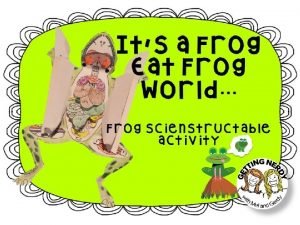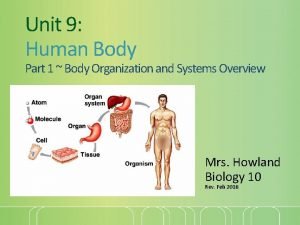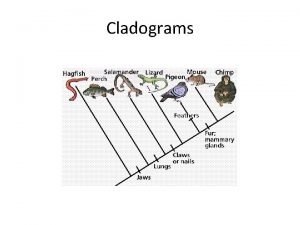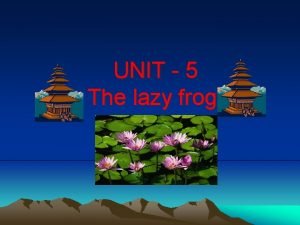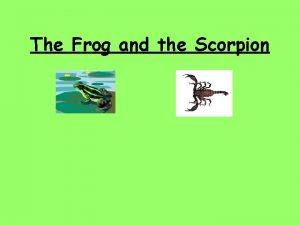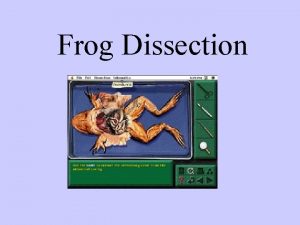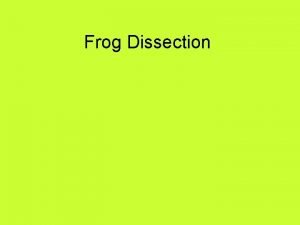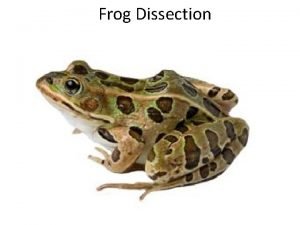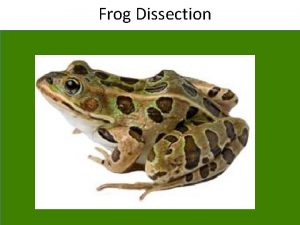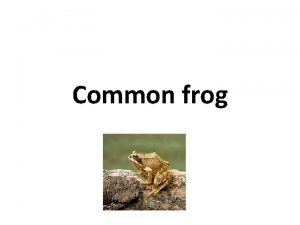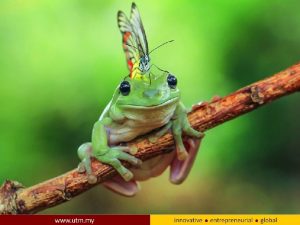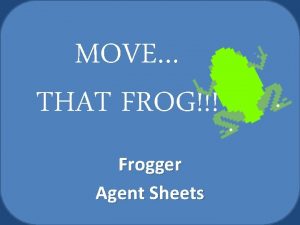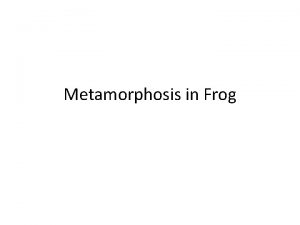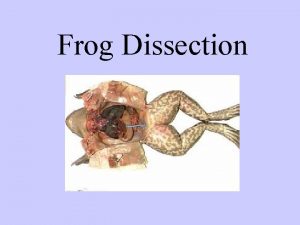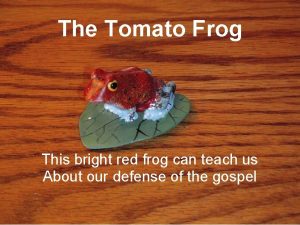Systems Unit Frog and Human Comparison The frog





















- Slides: 21

Systems Unit (Frog and Human Comparison)

The frog and human systems are very similar. We will be studying the systems and examining them on the frog.

Amphibians These are vertebrates that breathe through gills when young and live on land as an adult. l On land they breathe through lungs and their moist skin. l

Directions Anterior- above/head end l Posterior- below/hind end l Dorsal- back bone side l Ventral- belly side l

Skin- The Largest Organ Function- protection using sense receptors to prevent damage, and oil to prevent from drying out. l If you were to take off your skin and flatten it out, it would be the size of an area rug! l

2 Main Layers of the Skin Dermis & Epidermis

Epidermis l l l Upper skin Contains mostly dead skin cells Entire skin is recycled every 28 days Contains no blood cells. As new cells are made, they push up on the existing cells. Outer cells get less oxygen

Dermis Lower layer l Contains nerves and blood vessels and is thicker than the epidermis l The dermis is wavy & has extensions that form ridges in the epidermis. These ridges form your fingerprints. l Every person has a different pattern. l

Other Objects in The Skin l l l Hair and Nails Sweat Glands Oil Glands Fat Sense Receptors

Hair and Nails Formed from a tough fiber -like protein called keratin l The root and cuticle are alive, the hair and nails are dead l Hair is used to trap heat and keep the body warm l Nails protect the fingers l

Sweat Glands Sweat helps your body release extra salt and ½ liter of water every day. l Sweat helps to keep your body cool. l It acts like an air conditioner-as it evaporates from your skin, it releases heat and cools your body. l It is important to drink lots of fluids when sweating heavily to avoid dehydration. l

Oil Glands Produces oil to keep hair and skin from drying out. l Your scalp and face have more oil glands than any other part of your body. l

FAT Your body stores fat cells in your skin (under the dermis) l Fat helps regulate temperature – it traps heat l

Sense Receptors Your skin is one large sense organ l Skin contains special sense receptors for cold, hot, pain, pressure and touch l You have more touch receptors on your finger tips, palms, and lips than anywhere else l

Skin and Hair Color

Skin and Hair Color

Melanin l l l Melanin is a pigment that is produced by a layer of cells in the epidermis. The amount of melanin in your skin determines hair and skin color. Lots= black or dark brown skin Melanin + carotene= reddish or yellow skin Little= light tan None= albino

ZITS! The skin produces oil and it is this oil that clogs pores. l Bacteria can grow in the oil & cause changes that can irritate the skin. l Pimples are clogged and infected pores. l Puss is made up of white blood cells trying to fight the infection. l

Frog Skin Frog’s skin is moist and is protected by a slime layer that keeps the skin from drying out l Oxygen can diffuse through their skin l Their green color allows them to blend in with their surroundings l Some frogs have bright coloring that warns of poison l

Some External Anatomy

Tomorrow… You will be starting the frog dissection. l We will mainly be looking at the external anatomy of the frog. l You will need to rinse it and put it in the dissection pan. l More tomorrow… l
 Getting nerdy llc
Getting nerdy llc Limit comparision test
Limit comparision test Body organization
Body organization Unit 8 physiology of human body systems
Unit 8 physiology of human body systems Worm scienstructable 3d dissection model answer key
Worm scienstructable 3d dissection model answer key Tiger cladogram
Tiger cladogram Choose any vertebrates and create phylogenetic tree
Choose any vertebrates and create phylogenetic tree Unit 6 review questions
Unit 6 review questions Hay grading methodology
Hay grading methodology Ul 1069 requirements
Ul 1069 requirements Lms comparison matrix
Lms comparison matrix Vcaa hhd study design
Vcaa hhd study design Hình ảnh bộ gõ cơ thể búng tay
Hình ảnh bộ gõ cơ thể búng tay Ng-html
Ng-html Bổ thể
Bổ thể Tỉ lệ cơ thể trẻ em
Tỉ lệ cơ thể trẻ em Chó sói
Chó sói Chụp phim tư thế worms-breton
Chụp phim tư thế worms-breton Chúa sống lại
Chúa sống lại Môn thể thao bắt đầu bằng chữ đua
Môn thể thao bắt đầu bằng chữ đua Thế nào là hệ số cao nhất
Thế nào là hệ số cao nhất Các châu lục và đại dương trên thế giới
Các châu lục và đại dương trên thế giới
